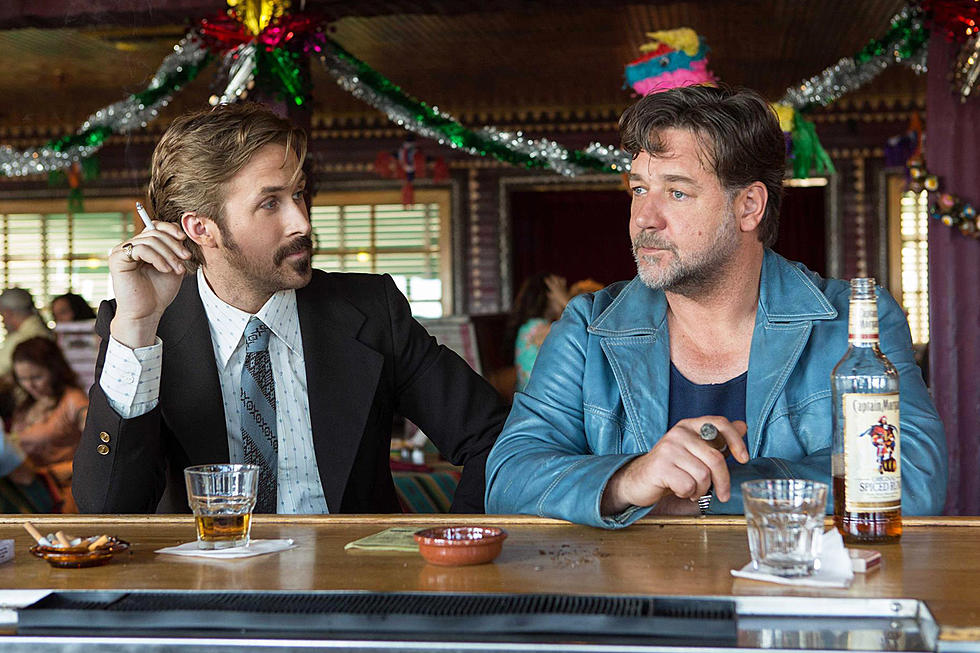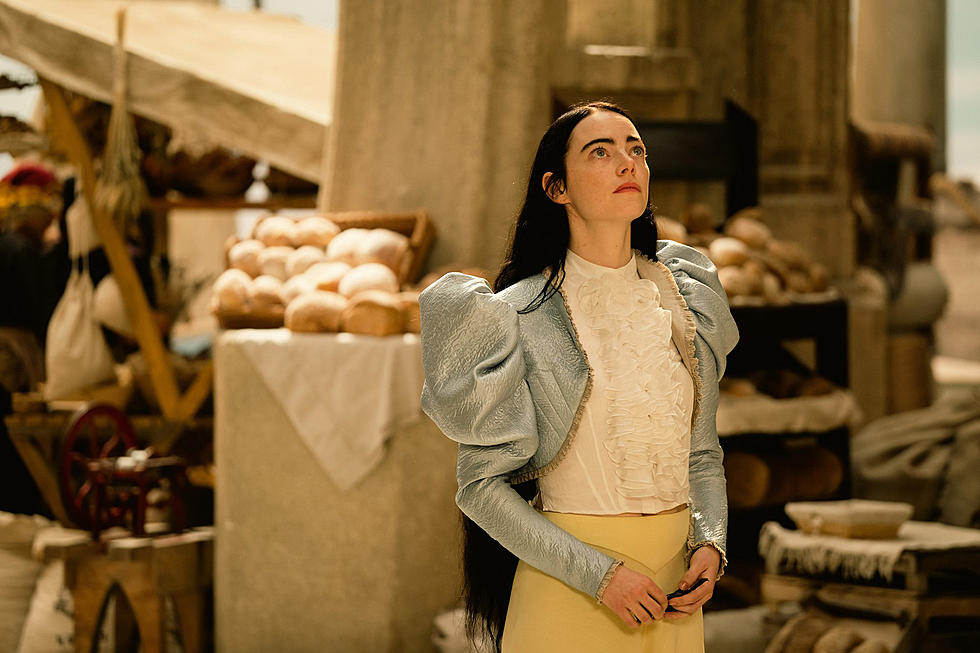
Let’s Start the ‘La La Land’ Backlash Backlash
The following essay contains SPOILERS for La La Land.
The signature image of Damien Chazelle’s La La Land — the one that adorns all of its posters and trailers, and this post as well — is of its two stars, Ryan Gosling and Emma Stone, dancing in the hills of Los Angeles. It’s a striking visual: Gosling in his dark wool (not polyester) suit, Stone in her canary yellow dress, each with one arm pointed skyward behind them and the other crossed and pointing to the ground. In this single pose, they’ve essentially diagrammed their characters’ entire journeys over the course of the film: They come from different worlds, meet, and send each others’ lives careening off in new directions, with the city of Los Angeles serving as the glittering backdrop to their romance.
The sky in that shot is notable too. Shot at magic hour, the horizon behind Gosling’s Sebastian and Stone’s Mia shines a soft purple. This particular shade of sunset pops up over and over throughout the film, so much Crayola could name a crayon after it: La La Lavender.
Here it is again in the Gosling solo number “City of Stars.”
Watch closely and you’ll also spot the same color in the film’s magnificent final scene, after Seb and Mia have gone their separate ways but then bump into each other by chance in his jazz club five years later. After a ballet sequence that represents his (or hers or perhaps their shared) fantasy of what their lives may have been like if they’d stayed together, Mia and her husband leave. As she reaches the door, she stops for a second — and suddenly there it is on her face; La La Lavender. His song has taken her back to that Los Angeles hill five years earlier. When she turns and looks back at Sebastian, the color’s gone, replaced by a deep blue. The sunset has faded, and given way to night.
The sunsets in La La Land are aesthetically pleasing, but they serve a thematic purpose too; this movie is about metaphorical sunsets as well as literal ones. In La La Land, everything is ending: Sunny days, romances, dreams, possibly jazz, and even an entire kind of moviemaking and moviegoing. Like sunsets, these things don’t last, but they sure are beautiful before they disappear.
Although the reaction to La La Land at the Venice and Toronto Film Festivals was overwhelmingly positive, and the movie is doing well in theatrical release, as its Oscar prospects increase so do the voices of naysayers who aren’t as enamored with the movie. Some are upset with its “clichéd” treatment of jazz music, which is perhaps not in as dire a state as Sebastian makes it sound, and probably doesn’t need a white guy like Sebastian as its champion anyway. Another popular essay compares the movie to a giant “mansplaining session.” The closer we get to the announcement of Oscar nominations, and the more likely it seems that La La Land will be the favorite in this year’s Best Picture race, the louder the complaints become, insisting over and over that the movie is inauthentic.
Let’s put aside the fact that all musicals are inherently inauthentic. (I haven’t sat in too many traffic jams that turned into parkour dance parties.) Let’s also put aside the fact that most musicals, La La Land included, play with heightened emotions — jazz isn’t just less popular than it once was, it’s dying — and the fact that if jazz was in a fantastic place and it was easy to make a living playing it, there wouldn’t be much tension in this movie. After all that, even if we take Sebastian’s opinion of jazz as a dying art form at face value, that doesn’t mean he’s correct. Numerous writers have focused on the fact that Sebastian wants to “save” jazz — evidence, in their minds, of the movie’s lack of knowledge about the current jazz world and its tone-deaf attitude toward race.
Although Sebastian is played by Ryan Gosling, a charming and likable guy with great bangs (and I mean those things are magnificent), La La Land treats him more like a lovably quixotic weirdo than a hero. All of La La Land’s best arguments about “saving” jazz are made by John Legend’s Keith, the man who offers Sebastian a lucrative sellout gig playing in his pop band, The Messengers (as in “Don’t shoot the...”).
In any other movie, Keith would be the villain. But he never tries to seduce Sebastian with promises of money and fame, and he has no interest in driving a wedge between him and Mia. He offers Sebastian a great job, seems genuinely concerned about his life, and makes excellent points about his overly nostalgic, retrograde attitudes — particularly with the line “How are you going to be a revolutionary when you’re such a traditionalist?” Keith’s not a bad dude; he’s the lone voice of reason.
Sebastian has no comeback to Keith’s comment. He’s such a traditionalist, in fact, that he hates playing keyboards— any keyboards— instead of an old-fashioned piano. When he works a pool party with an ’80s cover band, he’s disgusted that he has to debase himself by plunking out “I Ran” on a keytar. (He also calls himself a “serious musician,” which prompts Mia to laugh in his face.) That situation would probably embarrass a lot of professional musicians, but Sebastian seems equally offended by the slick keyboard rig at his first jam session with Keith’s band, and the long close-ups of the high-tech machine during the Messengers’ big musical number amplify his sense of discomfort. Sebastian’s final breaking point with the band isn’t the constant touring or the music that he doesn’t like, it’s a magazine photoshoot where he’s repeatedly called “Keyboard!” by the sleazy photographer. He is not a keyboard player. He’s a piano player — and a bit of a snob.
Does Chazelle have affection for Sebastian and his slightly self-important attitudes? Sure. At the end of the movie Sebastian gets what he wanted: A Los Angeles jazz club where he can play his songs. But he hasn’t saved jazz; it’s not even clear he’s saved his own career. On the night Mia and her husband wander in to Seb’s, they instantly get a great table right by the stage. There’s a fair number of people in the club, but it’s not exactly the Copacabana from GoodFellas. The place could easily close in six months.
Jazz experts might argue with the accuracy of Chazelle’s treatment of the music industry, but his treatment of the movie business is pretty much dead-on. There’s a beautiful subplot throughout La La Land about an arthouse theater, the Rialto, where Sebastian and Mia go to watch Rebel Without a Cause on their first date. Mia actually comes to the movie from a dinner with her boyfriend and another couple. Just before she bails to join Sebastian, the rest of the group is talking about how bad movies have gotten — especially when everyone is on their cell phone. Mia leaves and heads to the Rialto, and stands on the theater’s stage in front of the screen to find Sebastian.
I’ve heard a few people dismiss this moment as absurd — “Standing in front of the screen at a movie to find your date? Who does that?” — although they don’t seem to have a problem with these same characters floating through the cosmos as part of a musical number. Personally, I like Mia’s grand gesture because, as romantic as it is, it also proves her dinner companions right. Going to the movies does often suck. Sometimes you have to deal with jerks on their cell phones, and other times you have women just standing on stage in front of the screen, blocking your view of James Dean. And then their date stands up too!
A few moments later, the print of Rebel Without a Cause burns in the projector. Besides Sebastian and Mia, there’s maybe 15 people in the theater, and when Mia drives past the Rialto a few scenes after that, it’s closed for good. (So is the real Rialto in Los Angeles, although its current owner may restore it.) Film is literally dying in front of our eyes in La La Land. In a world where people don’t just look at their phones at the movies, they watch entire movies on their phones, why even bother making a gorgeous, widescreen original musical like La La Land? How can someone bring film into the future with one of the oldest genres in existence?
There are a lot of ambiguous elements to La La Land — Is Sebastian a hero or a jerk? Is Keith’s music good or bad? Should Mia and Sebastian have stayed together? Is the ending happy or sad? — but Chazelle is pretty unambiguous in his belief that artists should follow their passion wherever it leads. Not because it will save an artistic medium, or even because selling out is bad, but simply because if you don’t do what you truly love you will never be happy, even if doing what you love might not work out in the end. Few things do, but you can still make a beautiful sunset along the way.
More From ScreenCrush









